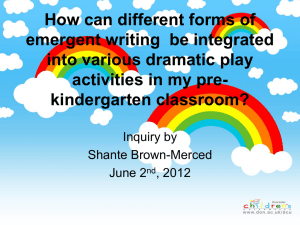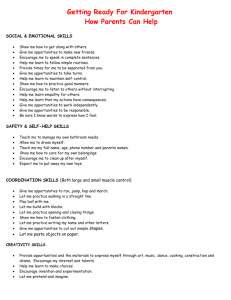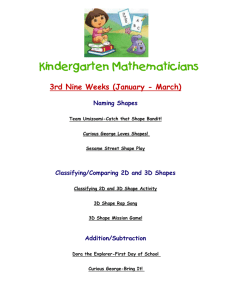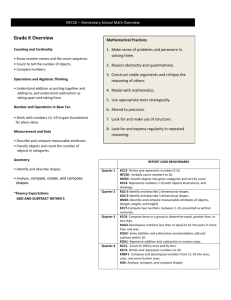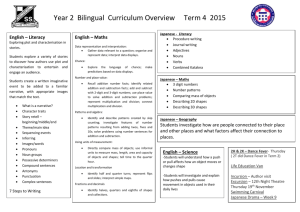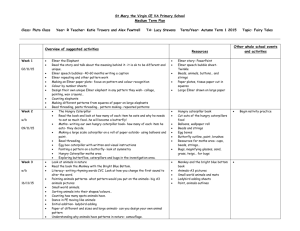Personal, Social and Emotional - Saints Peter and Paul Catholic
advertisement
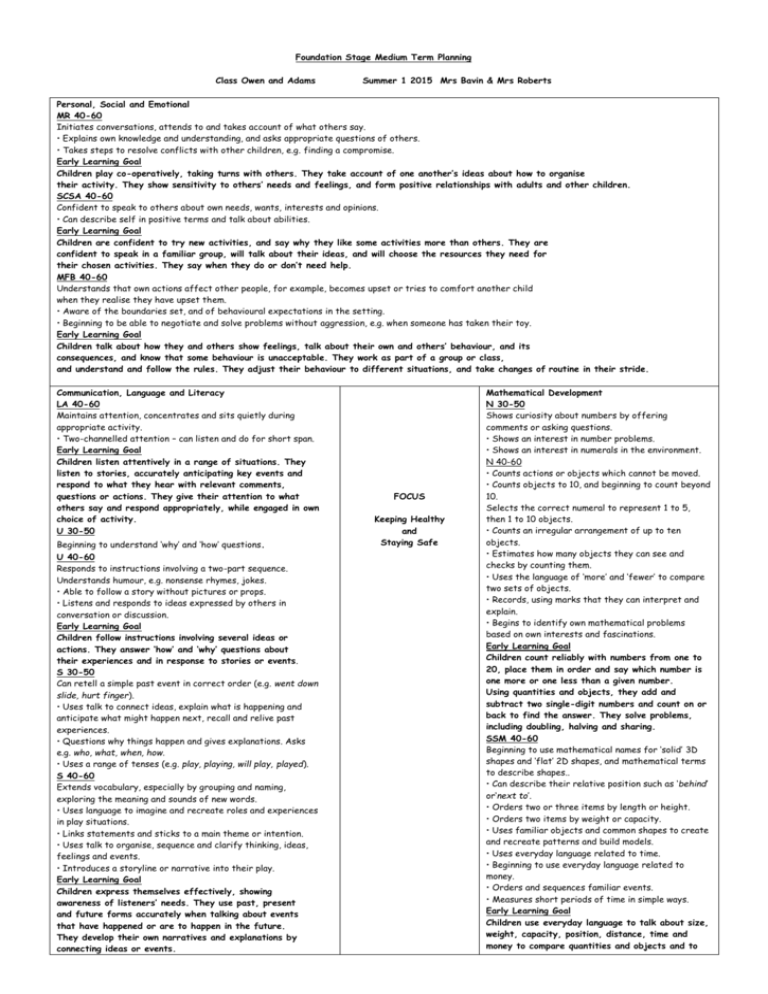
Foundation Stage Medium Term Planning Class Owen and Adams Summer 1 2015 Mrs Bavin & Mrs Roberts Personal, Social and Emotional MR 40-60 Initiates conversations, attends to and takes account of what others say. • Explains own knowledge and understanding, and asks appropriate questions of others. • Takes steps to resolve conflicts with other children, e.g. finding a compromise. Early Learning Goal Children play co-operatively, taking turns with others. They take account of one another’s ideas about how to organise their activity. They show sensitivity to others’ needs and feelings, and form positive relationships with adults and other children. SCSA 40-60 Confident to speak to others about own needs, wants, interests and opinions. • Can describe self in positive terms and talk about abilities. Early Learning Goal Children are confident to try new activities, and say why they like some activities more than others. They are confident to speak in a familiar group, will talk about their ideas, and will choose the resources they need for their chosen activities. They say when they do or don’t need help. MFB 40-60 Understands that own actions affect other people, for example, becomes upset or tries to comfort another child when they realise they have upset them. • Aware of the boundaries set, and of behavioural expectations in the setting. • Beginning to be able to negotiate and solve problems without aggression, e.g. when someone has taken their toy. Early Learning Goal Children talk about how they and others show feelings, talk about their own and others’ behaviour, and its consequences, and know that some behaviour is unacceptable. They work as part of a group or class, and understand and follow the rules. They adjust their behaviour to different situations, and take changes of routine in their stride. Communication, Language and Literacy LA 40-60 Maintains attention, concentrates and sits quietly during appropriate activity. • Two-channelled attention – can listen and do for short span. Early Learning Goal Children listen attentively in a range of situations. They listen to stories, accurately anticipating key events and respond to what they hear with relevant comments, questions or actions. They give their attention to what others say and respond appropriately, while engaged in own choice of activity. U 30-50 Beginning to understand ‘why’ and ‘how’ questions . U 40-60 Responds to instructions involving a two-part sequence. Understands humour, e.g. nonsense rhymes, jokes. • Able to follow a story without pictures or props. • Listens and responds to ideas expressed by others in conversation or discussion. Early Learning Goal Children follow instructions involving several ideas or actions. They answer ‘how’ and ‘why’ questions about their experiences and in response to stories or events. S 30-50 Can retell a simple past event in correct order (e.g. went down slide, hurt finger). • Uses talk to connect ideas, explain what is happening and anticipate what might happen next, recall and relive past experiences. • Questions why things happen and gives explanations. Asks e.g. who, what, when, how. • Uses a range of tenses (e.g. play, playing, will play, played). S 40-60 Extends vocabulary, especially by grouping and naming, exploring the meaning and sounds of new words. • Uses language to imagine and recreate roles and experiences in play situations. • Links statements and sticks to a main theme or intention. • Uses talk to organise, sequence and clarify thinking, ideas, feelings and events. • Introduces a storyline or narrative into their play. Early Learning Goal Children express themselves effectively, showing awareness of listeners’ needs. They use past, present and future forms accurately when talking about events that have happened or are to happen in the future. They develop their own narratives and explanations by connecting ideas or events. FOCUS Keeping Healthy and Staying Safe Mathematical Development N 30-50 Shows curiosity about numbers by offering comments or asking questions. • Shows an interest in number problems. • Shows an interest in numerals in the environment. N 40-60 • Counts actions or objects which cannot be moved. • Counts objects to 10, and beginning to count beyond 10. Selects the correct numeral to represent 1 to 5, then 1 to 10 objects. • Counts an irregular arrangement of up to ten objects. • Estimates how many objects they can see and checks by counting them. • Uses the language of ‘more’ and ‘fewer’ to compare two sets of objects. • Records, using marks that they can interpret and explain. • Begins to identify own mathematical problems based on own interests and fascinations. Early Learning Goal Children count reliably with numbers from one to 20, place them in order and say which number is one more or one less than a given number. Using quantities and objects, they add and subtract two single-digit numbers and count on or back to find the answer. They solve problems, including doubling, halving and sharing. SSM 40-60 Beginning to use mathematical names for ‘solid’ 3D shapes and ‘flat’ 2D shapes, and mathematical terms to describe shapes.. • Can describe their relative position such as ‘behind’ or‘next to’. • Orders two or three items by length or height. • Orders two items by weight or capacity. • Uses familiar objects and common shapes to create and recreate patterns and build models. • Uses everyday language related to time. • Beginning to use everyday language related to money. • Orders and sequences familiar events. • Measures short periods of time in simple ways. Early Learning Goal Children use everyday language to talk about size, weight, capacity, position, distance, time and money to compare quantities and objects and to R 30-50 solve problems. • Beginning to be aware of the way stories are structured. They recognise, create and describe patterns. • Suggests how the story might end. They explore characteristics of everyday objects • Listens to stories with increasing attention and recall. and shapes and use mathematical language to • Describes main story settings, events and principal characters. describe them. • Recognises familiar words and signs such as own name and advertising logos. R 40-60 Hears and says the initial sound in words. • Can segment the sounds in simple words and blend them together and knows which letters represent some of them. • Links sounds to letters, naming and sounding the letters of the alphabet. • Begins to read words and simple sentences. • Uses vocabulary and forms of speech that are increasingly influenced by their experiences of books. • Enjoys an increasing range of books. • Knows that information can be retrieved from books and computers. Early Learning Goal Children read and understand simple sentences. They use phonic knowledge to decode regular words and read them aloud accurately. They also read some common irregular words. W30-50 Ascribes meanings to marks that they see in different places. W 40-60 Gives meaning to marks they make as they draw, write and paint. • Continues a rhyming string. • Hears and says the initial sound in words. • Can segment the sounds in simple words and blend them together. • Links sounds to letters, naming and sounding the letters of the alphabet. • Uses some clearly identifiable letters to communicate meaning, representing some sounds correctly and in sequence. • Writes own name and other things such as labels,captions. • Attempts to write short sentences in meaningful contexts. W ELG Children use their phonic knowledge to write words in ways which match their spoken sounds. They also write some irregular common words. They write simple sentences which can be read by themselves and others. Some words are spelt correctly and others are phonetically plausible. Knowledge and Understanding Physical Development Creative Development PC 30-50 MH 30-50 EMM 40-60m Shows interest in different occupations and Can copy some letters, e.g. letters from their name. Begins to build a repertoire of songs ways of life. MH 40-60 and dances. Experiments with different ways of moving. • Explores the different sounds of PC 40-60 Enjoys joining in with family customs and • Jumps off an object and lands appropriately. instruments. routines. • Negotiates space successfully when playing racing and • Explores what happens when they chasing games with other mix colours. Early Learning Goal children, adjusting speed or changing direction to avoid • Experiments to create different Children talk about past and present events in obstacles. textures. their own lives and in the lives of family • Travels with confidence and skill around, under, over and • Understands that different media members. They know that other children don’t through balancing and can be combined to create always enjoy the same things, and are climbing equipment. new effects. sensitive to this. They know about similarities • Shows increasing control over an object in pushing, patting, • Manipulates materials to achieve a and differences between themselves and throwing, catching or planned effect. others, and among families, communities and kicking it. • Constructs with a purpose in mind, traditions. • Uses simple tools to effect changes to materials. using a variety of resources. TW 30-50 Comments and asks questions about aspects of • Handles tools, objects, construction and malleable materials • Uses simple tools and techniques their familiar world such as the place where safely and with competently and appropriately. they live or the natural world. increasing control. • Selects appropriate resources and • Talks about why things happen and how things • Shows a preference for a dominant hand. adapts work where necessary. work. • Begins to use anticlockwise movement and retrace vertical • Selects tools and techniques • Shows care and concern for living things and lines. needed to shape, assemble and the environment. • Begins to form recognisable letters. join materials they are using. • Uses a pencil and holds it effectively to form recognisable TW 40-60 BI 40-60 Looks closely at similarities, differences, letters, most of which *Create simple representations of patterns and change. are correctly formed. events, people and objects. Early Learning Goal • Initiates new combinations of Early Learning Goal movement and gesture in order Children know about similarities and Children show good control and co-ordination in large and to express and respond to feelings, differences in relation to places, objects, small movements. ideas and experiences. materials and living things. They move confidently in a range of ways, safely • Chooses particular colours to use They talk about the features of their own negotiating space. They handle equipment and tools for a purpose. immediate environment and how environments effectively, including pencils for writing. • Introduces a storyline or narrative might vary from one another. They make HSC 40-60 observations of animals and plants and explain why some things occur, and talk about changes. T 30-50 Knows how to operate simple equipment, e.g. turns on CD player and uses remote control. T 40-60 Completes a simple program on a computer. • Uses ICT hardware to interact with ageappropriate computer software. Early Learning Goal Children recognise that a range of technology is used in places such as homes and schools. They select and use technology for particular purposes. Area of Provision Library Role-play Malleable Writing corner Workshop Knowledge and understanding Small world Maths Art Eats a healthy range of foodstuffs and understands need for variety in food. • Usually dry and clean during the day. • Shows some understanding that good practices with regard to exercise, eating, sleeping and hygiene can contribute to good health. • Shows understanding of the need for safety when tackling new challenges, and considers and manages some risks. • Shows understanding of how to transport and store equipment safely. • Practices some appropriate safety measures without direct supervision. Early Learning Goal Children know the importance for good health of physical exercise, and a healthy diet, and talk about ways to keep healthy and safe. They manage their own basic hygiene and personal needs successfully, including dressing an going to the toilet independently. Enhancements – Additional Resources, Visits, Visitors, Displays. Stranger danger. Safety on the roads. My body books. Books linked to interest (Deadly 60, turtles, super heroes, princesses, fairies). Story sacks & Magazines. Information books-life cycles. (Frog & butterfly) People who help us books (non-fiction) Visit to library. Gym – outdoor & exercise cards Lollipop sticks and zebra crossing-outdoors. People who help us outfits. Shop Baby clinic/hospital or vet Addition & subtraction dough mat cards. Counting in two’s dough cards. Rocket 1-10 dough cards. Lego area Small coloured sand, gloop, tweezers. Recipe books and food magazines. Recipe writing frames and pencils. Healthy eating menus. Lists of food they like and dislike. Making books/magazines resources. Magnetic letters & boards. Writing frames (thick lines and picture box) and writing for different purposes. Add wheels and boxes to make vehicles / traffic lights, road signs. Resources to make fairy & elf homes into their play. • Plays cooperatively as part of a group to develop and act out a narrative. Early Learning Goal Children use what they have learnt about media and materials in original ways, thinking about uses and purposes. They represent their own ideas, thoughts and feelings through design and technology, art, music,dance, role play etc. Resource Implications Books. Story sacks & magazines. Book & life cycle toys. Mini bus/risk assess Benches, mats, blocks for steps, dumbbells, hoops. Road signs & people who help us outfits. Real boxes, till, money, basket etc. Real boxes, money, till, price tags etc Dolls, charts, scales, nappies etc As stated. Images of models, labelled baskets, books As stated. Menus. Cut outs from magazines. For example, Gormiti, Ben 10, Barbie etc As stated Linked to interests/topic e.g.super heroes, fairies, growing, butterfly, caterpillar, policeman and shopping lists, party invitations, postcard, recipes etc. Wheels, boxes, pictures. Paper, paste, balloons, card, collage materials. Twigs, leaves, branches, shells, straw etc Continue with growth & investigations. For example, celery & food dye. caterpillars Set up investigation table-looking at toy teeth, skeleton & body organs etc. Road signs-outdoors. Floating and sinking activity in water tray. Magnets. Visit from Acorn farm & visit to Farmer Teds. Using age appropriate games-Ipad/IWB Add fairy & elf areas (Interests) As stated. Board games-some with numbers beyond 20. Addition and subtraction cards. Magnetic numbers and +/-/= symbols. Addition and subtraction board games. Bee bot & mats Shop area-fruit & veg (Half/doubles) Challenge box-problem solving. Still life-flowers, fruit, artefacts, found items, objects of interest such as superheroes & fairies etc. Artist pictures. plasticine/clay Board games Books, photos & writing/drawing materials. As stated Variety of object to experiment with. As above, plus magnets. As stated Counters, dice. Till, basket, money, price tags As stated As stated. Different mediums & medias. Visitors Outdoors Area of Learning Communication, Language and Literacy Mathematical Development Knowledge and Understanding of the World Fire-brigade. Police. Lollypop person/postman etc Dentist Everton Football club Gym equipment Fairy land Planting Science lab As stated As stated Variety of resources to make homes for fairies. Book, toy fairies, little door Plants, flowers, bulbs, seeds Test tubes, food colouring, pipettes, glitter, pots etc. Focused Activities *RWI linked to set. * Alphabet games/jigsaws *Alphabet soundtracks bingo – letter/sound link. *Education city/Ipad games. *Keyword games – bingo, fishing game, computer games. *Big books – including non fiction, look at contents page, index, talk about labels and instructions. *Names – practise writing both names on whiteboards and tracing paper. *Reading – Literacy links, Songbirds, RWI and ORT, encourage children to use pictures cue to predict. Pointing left to right. Talk about setting, characters etc. *Writing for different purposes. E.g, card, sign, caption. *Model writing for different purposes e.g. shopping list, letter, party invitation, story book, recipe to encourage children to write simple sentences. Drama- acting out stories using puppet theatre and masks/ puppets. Story phones to listen with enjoyment to common and uncommon stories. *Word trail. * Share stories that reflect the diversity of children’s experiences. *Speaking and listening games (circle games – swap places) *Yes/No Question game (e.g. hide object and then children have to ask questions about it to work out what it is, adult can only say yes or no) *Number game – bingo card, match numeral to number of objects on card. *1 more/1 less – roll dice and say/show what is 1 more/less. Flash cards, teacher shows a card children show one more/less. Floor number tilesjump on number that is 1 more/1 less etc. *Counting circle games, beyond 20 forwards and backwards – Try 2’s, 5’s, 10’s when ready. *Largest/smallest number – as above. Children given a selection of numbers and have to sort from smallest to largest. *Looking at number patterns, sequences. *Addition and subtraction board games. * Bee-bot roamer. * Subtraction – Hungry Caterpillar eating the food, how many left? * Subtraction games on smartboard / laptops. * Addition – Hungry Caterpillar, add together two lots of food to find the total that he ate. * Dough cards-addition & subtraction. * Symmetry – butterfly paintings, natural materials. * Education city. * Comparing weight, height, length etc. Practical activities. Non-standard then standard. *Measuring short periods of time with sand timers & stop watch. *Doubling games/activities. *Halving games/activities. * Make books about shape, time and measure: shapes found in the environment; long and short things; things of a specific length; and ones about patterns, or comparing things that are heavier or lighter. * Hungry Caterpillar – taste foods of Hungry Caterpillar and identify likes and dislikes using senses. * Make a healthy fruit salad for the Hungry Caterpillar to prevent his tummy ache. * Describe texture and shape of fruit – feely bag game. * Discuss what makes up the body, e.g. skeleton, heart, lungs, brain, blood, skin etc. What happens to these after exercise? Carry out investigation – finding pulse, counting heart rate before and after. * Make a class ‘My exercise chart’. *Draw/paint – What I want to be when I grow up – display work –ch could do some writing to go with it. * Visit from dentist regarding keeping teeth clean. *Visit from fire-fighters/Everton Football club *Visit from Acorn Farm. Visit to Farmer Teds. * Road Safety – people who help us cross the road. * Road signs outdoors. *Walk around local environment-look at likes & dislikes. *Observe/discuss and record changes over time. Seeds, bulb, experiments, caterpillars. Resource Implications See RWI plans As stated Keywords cards, fish game. Alphabet soundtrack bingo. Big book – Road Safety. Name cards, whiteboards, pens, tracing paper. Reading scheme books differentiated for group work. As stated Different writing frames and pictures related to children’s interests and wide variety of topics. Bingo cards, picture cards. Number fans, dice, flash cards. Teddy/Fred to pass around. Splat square on IWB, large hundred square, number flashcards, board games, number lines, dice and counters. Bee-bot roamer, mats. Caterpillar, pictures of food. Laptops Dough cards Clip boards Paint Compare buckets of objects, ribbon to measure length Hungry Caterpillar Story and foods. Fruit. Feely bag and fruit. Body parts from science resources. Organise visits. As stated *Operate c.d player/camera/Ipad. * Invite children and families with experiences of living in other countries to bring in photographs and objects from their home cultures including those from family members living in different areas of the UK and abroad. * Provide stimuli and resources for children to create simple maps and Creative Development Physical Development P.S.E.D plans, paintings, drawings and models of observations of known and imaginary landscapes. • Give opportunities to design practical, attractive environments, for example, taking care of the flowerbeds or organising equipment outdoors *Look at and discuss fruit, talk about shapes, colours, patterns. Draw fruit and use oil pastels or water colours. * Look at artists work. Discuss likes/dislikes & try out techniques. *Follow music express scheme for music. • Introduce children to a wide range of music, painting and sculpture. • Encourage children to take time to think about painting or sculpture that is unfamiliar to them before they talk about it or express an opinion. * Plan imaginative, active experiences, such as ‘Going on a bear hunt’. Help them remember the actions of the story . * Offer a story stimulus by suggesting an imaginary event or set of circumstances, e.g., “This bear has arrived in the post. He has a letter pinned to his jacket. It says ‘Please look after this bear.’ We should look after him in our class. How can we do that?’ * Extend children’s experience and expand their imagination through the provision of pictures, paintings, poems, music, dance and story. * Provide activities that give children the opportunity and motivation to practise manipulative skills, e.g. cooking, painting, clay and playing instruments. • Provide play resources including small world toys, construction sets, threading and posting toys, dolls’ clothes and material for collage. • Teach children skills of how to use tools and materials effectively and safely and give them opportunities to practise them. • Provide a range of construction toys of different sizes, made of wood, rubber or plastic, that fix together in a variety of ways, e.g. by twisting, pushing, slotting or magnetism. * Plan opportunities, particularly after exercise, for children to talk about how their bodies feel. • Find ways to involve children so that they are all able to be active in ways that interest them and match their *To travel and balance with control when holding stretched or curled shapes. * To stop and start on a given signal and share space safely. * To show an awareness of contrasts in level. * To link two movements together. * To bounce, hop, spring and jump using a variety of take offs and landings. * To observe, recognise and copy different body shapes. * To link together two or more actions with control and be able to repeat them. *Practise throwing and catching skills with different resources and sized equipment. * Outdoor gym. * Finding your pulse and counting your breathing rate. * R.E-Good news and friends - See Come and See plan *R.E – Read bible stories. * Stranger danger DVD. * Safety on the roads and railways through role play in small world. * Dressing independently, putting shoes on correct feet, and fastening buttons and zips. *SEAL-Going for goals! ac * Board games-turn taking. * Circle time *Play circle games outside (Duck, duck goose, wake up giant etc) Oil pastels/watercolours. Variety of collage materials. Cooking materials. Artist artefacts/pictures etc Music express bk, c.d & instruments. Val Sabin gymnastics scheme: D – Flight – Bouncing, Jumping, Landing. Benches, mats, steps, hoops, dumbbells. Beanbags, quoits, tennis balls, basket ball, footballs. Come and See Scheme DVD Small world. PE kit, coats. See seal book Games
